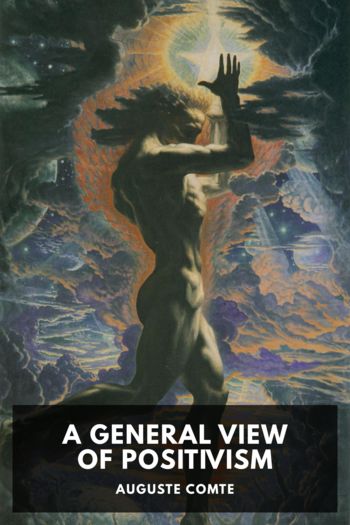A General View of Positivism - Auguste Comte (the snowy day read aloud TXT) 📗

- Author: Auguste Comte
Book online «A General View of Positivism - Auguste Comte (the snowy day read aloud TXT) 📗». Author Auguste Comte
To live in others is, in the truest sense of the word, life. Indeed the best part of our own life is passed thus. As yet this truth has not been grasped firmly, because the social point of view has never yet been brought systematically before us. But the religion of Humanity, by giving an aesthetic form to the Positivist synthesis, will make it intelligible to minds of every class: and will enable us to enjoy the untold charm springing from the sympathies of union and of continuity when allowed free play. To prolong our life indefinitely in the Past and Future, so as to make it more perfect in the Present, is abundant compensation for the illusions of our youth which have now passed away forever. Science which deprived us of these imaginary comforts, itself in its maturity supplies the solid basis for consolation of a kind unknown before; the hope of becoming incorporate into the Great Being whose static and dynamic laws it has revealed. On this firm foundation Poetry raises the structure of public and private worship; and thus all are made active partakers of this universal life, which minds still fettered by theology cannot understand. Thus imagination, while accepting the guidance of reason, will exercise a far more efficient and extensive influence than in the days of Polytheism. For the priests of Humanity the sole purpose of Science is to prepare the field for Art, whether aesthetic or industrial. This object once attained, poetic study or composition will form the chief occupation of our speculative faculties. The poet is now called to his true mission, which is to give beauty and grandeur to human life, by inspiring a deeper sense of our relation to Humanity. Poetry will form the basis of the ceremonies in which the new priesthood will solemnise more efficiently than the old, the most important events of private life: especially Birth, Marriage, and Death; so as to impress the family as well as the state with the sense of this relation. Forced as we are henceforth to concentrate all our hopes and efforts upon the real life around us, we shall feel more strongly than ever that all the powers of Imagination as well as those of Reason, Feeling, and Activity, are required in its service.
Poetry once raised to its proper place, the arts of sound and form, which render in a more vivid way the subjects which Poetry has suggested, will soon follow. Their sphere, like that of Poetry, will be the celebration of Humanity; an exhaustless field, leaving no cause to regret the chimeras which, in the present empirical condition of these arts, are still considered indispensable. Music in modern times has been limited almost entirely to the expression of individual emotions. Its full power has never been felt in public life, except in the solitary instance of the “Marseillaise,” in which the whole spirit of our great Revolution stands recorded. But in the worship of Humanity, based as it is on Positive education, and animated by the spirit of Poetry, Music, as the most social of the special arts, will aid in the representation of the attributes and destinies of Humanity, and in the glorification of great historical types. Painting and Sculpture will have the same object; they will enable us to realize the conception of Humanity with greater clearness and precision than would be possible for Poetry, even with the aid of Music. The beautiful attempts of the artists of the sixteenth century, men who had very little theological belief, to embody the Christian ideal of Woman, may be regarded as an unconscious prelude to the representation of Humanity, in the form which of all others is most suitable. Under the impulse of these feelings, the sculptor will overcome the technical difficulties of representing figures in groups, and will adopt such subjects by preference. Hitherto this has only been effected in bas-reliefs, works which stand midway between painting and sculpture. There are, however, some splendid exceptions from which we can imagine the scope and grandeur of the latter art, when raised to its true position. Statuesque groups, whether the figures are joined or, as is preferable, separate, will enable the sculptor to undertake many great subjects from which he has been hitherto debarred.
In Architecture the influence of Positivism will be felt less rapidly; but ultimately this art like the rest will be made available for the new





Comments (0)